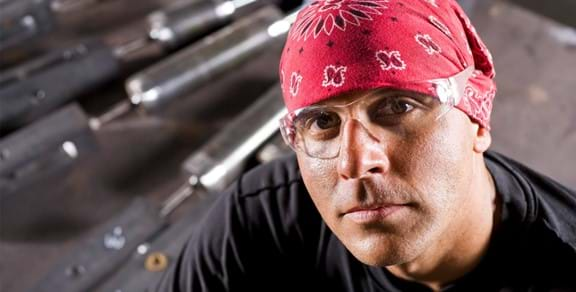GorillaPro® Threadlocker FAQ

How do threadlockers work?
When you apply a liquid or gel threadlocker into the threads or area between metal parts it forces air (oxygen) out of the space. In the presence of metal, the lack of air causes the liquid adhesive to harden to a durable acrylic. The hardened acrylic will then fill all the voids between the metal substrates and develop great strength or keep them from leaking and corroding.
When should you use a red high-strength threadlocker instead of a blue medium-strength threadlocker?
For most applications the blue medium-strength threadlocker is more than sufficient to secure and prevent vibration from loosening the fasteners. In more critical, high torque or high-pressure applications the red, high-strength products would be recommended. Examples are heavy equipment, overhead cranes, high pressure hydraulics and applications for permanent bonding of fasteners/studs.
Can you ever remove a red permanent threadlocker?
Yes. If you heat up the bonded assembly above the working temperature of the threadlocker, it will soften and can be easily removed without damaging the assembled parts.
Can you use a threadlocker on non-threaded parts like shafts, bushings and bearings?
Yes. You can use a threadlocker on a smooth metal part and a retaining compound on a threaded metal part. Sometimes the different type of product may have specific advantages in viscosity, temperature, speed of cure and strength preferred for that application. That said, a retaining compound is commonly used in many situations with non-threaded parts.
How clean do parts need to be before using a threadlocker, and do I need a primer?
While cleaner is always the better, the new chemistry in GorillaPro threadlockers will cure even with some residual oil or grime. Primers are used to speed up the rate of cure, so the assembled equipment can get back into service faster. In most cases outside of Inert metals, a primer is not necessary to reach full cure/acceptable set times. Primers are used in situations where the metal substrates are not providing the proper concentrations/amounts of metal oxidation.
Where do you apply the threadlocker when putting a bolt into a blind hole?
You should apply the threadlocker into the blind hole so that the air inside will be displaced outwards and not trapped inside, which inhibits the curing. In addition, it is useful to also apply the threadlocker to the bolt to ensure proper void fill.
Can you use a threadlocker on plastic parts?
No. Threadlockers, or anaerobic adhesives, are designed for use on metal parts only. Other GorillaPro adhesives like epoxies or instant adhesives can be use on plastic parts. Anaerobic threadlockers can lead to the drying or cracking of many plastics.
What is an active metal and an inactive metal?
Active metals are metals that easily rust, such as brass, bronze, iron and steel. Inactive metals are aluminum, stainless steel and some plated metals like chrome. The threadlocker will set up slower on inactive metals due to their need of reduction/oxidation equations on the metal surface. Threadlockers rely on these equations to initiate/catalyze the cure of the adhesive once oxygen is removed.
Why are the bottles only half filled?
Anaerobic adhesives, such as threadlockers, do not harden when exposed to air. There is a large air space in the bottles preserve the integrity of the product and maintain its shelf life in storage. Therefore, a 50ml bottle of an anaerobic adhesives contains 50mls of adhesive and 50mls (by volume) of air.
Why do threadlockers come in different colors?
The color coding goes back to the original military specifications that were created for classifying the different product’s values and characteristics. In the MIL specs purple is low-strength, blue is medium-strength and red and green are high-strength.
Can you re-use worn screws and bearings?
Not really. Fasteners can be bent and have threads that have become stretched. Bearings can be worn beyond safe and functional use. New parts should be installed into existing housings, shafts and equipment with the aid of anaerobic adhesives and sealants.